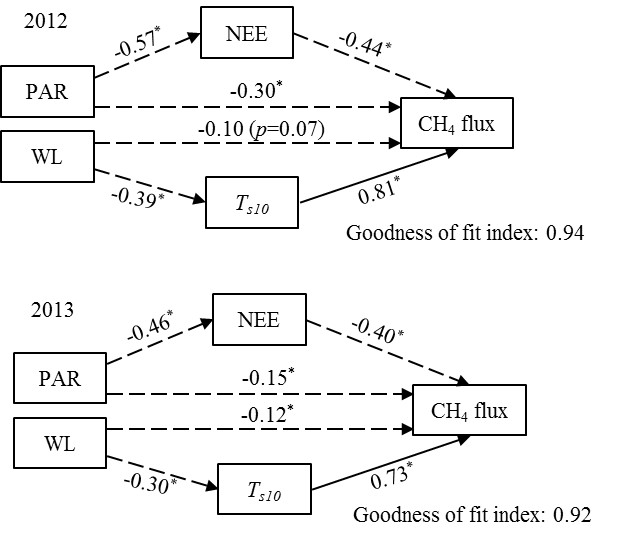China contains a considerable amount of wetlands, representing about 4% of China’s surface area. Yet, only a few whole ecosystem studies of wetland methane flux have taken place in China. To understand the impact of climate change on greenhouse gas emission of wetlands is of critical concern for regional and national assessments.
Recently, a research group from Northeast Institute of Geography and Agroecology, CAS, conducted continuous field observations on ecosystem CH4 emission from a permafrost peatland located in the Da Xing’anling Mountains and a non-permafrost, freshwater marsh on the Sanjiang Plain using the eddy covariance technique. These wetlands are the two most dominant natural wetland types in northeast China. The research aims to understand the differences in the magnitude and seasonal pattern of CH4 fluxes and dominant drivers of CH4 exchange from these two wetlands.
Researchers found large differences in seasonal pattern and magnitude of CH4 exchange for these two wetlands. CH4 exchange did not show an obvious diurnal cycle, except for weak diurnal variation at the marsh site during the peak growing season of 2013. Peak CH4 emissions at the peatland occurred in the late growing season and was more than two months later than those of the marsh. Total seasonal CH4 emission from the peatland, 0.38 to 1.27 g C-CH4 m-2, was one order of magnitude smaller than those at the marsh, 19.71 to 21.8 g C-CH4 m-2. For the peatland average soil temperature between 10 cm to 60 cm depths was most strongly correlated with seasonal CH4 variability, but thaw depth was also important during the late growing season. At the marsh soil temperature at 10 cm depth and net ecosystem CO2 exchange were the main factors related to CH4 flux.
This study presents the first detailed comparison of ecosystem-scale CH4 exchange in two principal typical wetland ecosystems of northeast China. The results suggested that the differences in magnitude and responses of CH4 flux to changes in environmental and biophysical conditions of these different wetland types should be considered when estimating the regional and national carbon budgets and response to future disturbance from land cover change and climate warming.

Fig.1.Path diagrams for the peatland illustrating the effects of environmental parameters on CH4 flux during the growing seasons.

Fig.2.Path diagrams for the marsh illustrating the effects of environmental parameters on CH4 flux during the growing seasons.
The research paper by Li Sun and Changchun Song et al. was published in the Journal of Agricultural and Forest Meteorology.
https://doi.org/10.1016/j.agrformet.2017.11.009
Li Sun, Changchun Song*, Peter M. Lafleur, Yuqing Miao, Xianwei Wang, Chao Gong, Tianhua Qiao, Xueyang Yu, Wenwen Tan. Wetland-atmosphere methane exchange in Northeast China: A comparison of permafrost peatland and freshwater wetlands. Agricultural and Forest Meteorology, 2018, 249, 239-249.